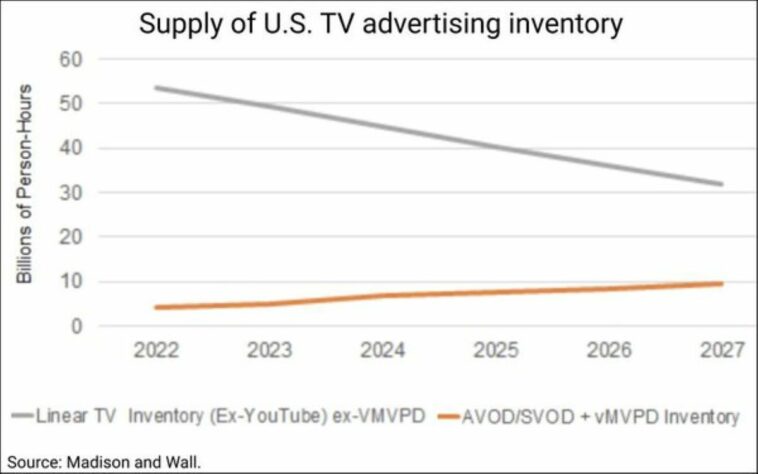The evolving landscape of television consumption is steering towards a digital revolution, creating an environment where linear TV faces a substantial challenge. Brian Wieser, an expert from Madison and Wall, projects a considerable drop in linear TV and connected TV advertising inventory between 2023 and 2027. The estimated decline is an alarming 24%, signifying an average annual drop of approximately 6.6%. The driving forces behind this seismic shift include the waning allure of “ambient” linear content consumption and a diminishing linear TV network penetration, primarily due to the continual decline of pay TV subscriptions.
Simultaneously, the streaming TV realm is poised to experience continuous and robust growth. Viewers are increasingly migrating to the digital landscape, resulting in a substantial gap in ad inventory between traditional linear and emerging streaming platforms.
The projection also underscores the dwindling role of advertising in the overall TV consumption landscape. By 2023, advertising’s share of the total time spent with TV is estimated to be 13.1%. However, this is predicted to fall to 10.6% by 2027. This transformation is partly attributed to the disparity in ad loads between streaming and linear TV. Notably, major premium streaming services such as Disney+, Netflix, Max, Paramount+, and Prime Video display approximately four minutes of advertising per hour. This pales in comparison to linear TV, where an average of 12 minutes per hour is dedicated to advertising, especially on broadcast networks. A few streaming platforms like Tubi, Hulu, and Roku deviate from the trend, with ad loads of around five to eight minutes per hour, still significantly lower than traditional linear TV.
Brian Wieser also highlights the potential game-changer – Netflix’s foray into the advertising realm. The introduction of a Netflix advertising tier could substantially impact the ad inventory trajectory, potentially altering the balance between linear and streaming TV.
By 2027, the scale is expected to tip heavily in favor of streaming TV, accounting for 54% of the total TV viewing, while linear TV will constitute the remaining 46%. This is in stark contrast to the current landscape, where streaming TV accounts for around 32%, while linear TV (comprising both broadcast and cable) still dominates with a 68% share.
Should YouTube and similar platforms be incorporated into the analysis, the combined share is predicted to reach 19% of the total linear/streaming consumption within four years. Nevertheless, even with this broader view, the overall ad-supported TV inventory will experience a considerable 13% reduction between 2022 and 2027.
This transformation marks a pivotal moment in the television industry’s evolution, necessitating an adaptation in advertising strategies and platforms as the dichotomy of linear and streaming TV unfolds. More and more people are using streaming services to listen to music, and podcasts, and watch TV online whenever they want. They’re saying goodbye to old cable TV and embracing the freedom of digital streaming. Because of this change, advertisers are also shifting their strategies. They’re moving their advertising money from traditional radio and TV to new places like digital audio and connected TV (CTV). Recently, Spotify and Roku have joined forces, symbolizing the shift towards this new era.







Comments
Loading…